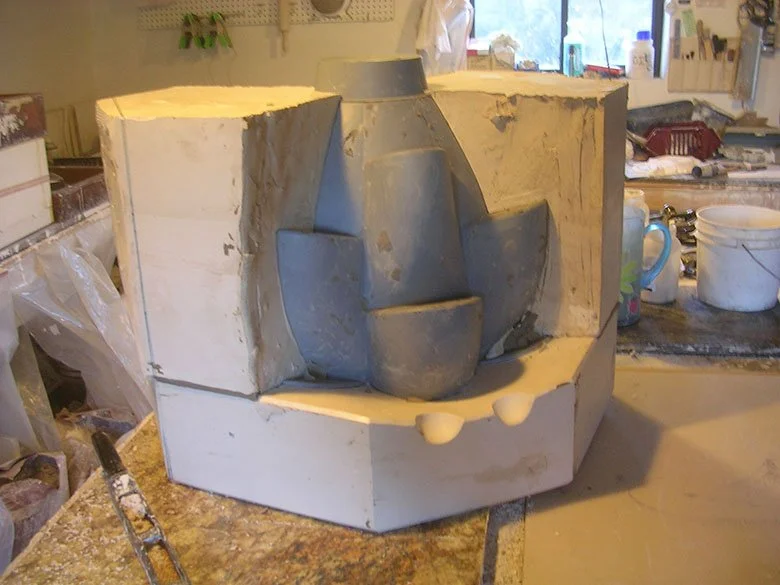Nature Planter for Design Night
Nature Planter is a ceramic vessel used for growing a variety of herbs and flowers. The largest opening at the top can hold plants that need to root deeper. Opening like an artichoke, the form allows the individual pockets to collect water.
Description and Process
Design Night was a collaborative design venture dedicated to exploring passions and pioneering innovative design methods, manufacturing processes, and materials. Projects undertaken by Design Night have garnered recognition in publications such as Blueprint, Dwell, The Oregonian, and Eric Chan’s 1000 Product Designs. Among these projects, Nature Planter stands out as a testament to pushing the boundaries of slip casting technique in terms of scale and post-production refinement. The project journey began with conceptual sketch ideation, evolving into the creation of rough 3D CAD models. Upon finalizing the design direction, development of a full-size pattern ensued, culminating in the initiation of production in collaboration with a skilled potter.
The problem
Innovate and expand the horizons of a substantial functional slip-cast vessel, designed to enhance horticultural practices. Craft the form to facilitate water collection while optimizing openings for user engagement. Accommodate a single large deep-rooted plant and facilitate the growth of multiple subsequent plants around the base.
My role
Lead industrial designer, Graphic designer, Lead production designer, Marketing/Sales, and Merchandising.
Sketch ideation
"Research, ideate, prototype, test, repeat" encapsulates my process: understanding the problem through research, ideation during rapid visualization, exploring solutions via prototyping, gathering user feedback through testing, and refining through iterative cycles.
3D CAD
Two concepts progressed to the CAD phase, undergoing scrutiny for manufacturability and brand alignment. Scaled models were then crafted for both, followed by discussions on concept viability between design and manufacturing partners. The top concept was chosen primarily for its unique design and its capacity to attract attention online and within design communities.
Production drawings
Section views were generated to enhance comprehension of creating undercuts and to identify weaknesses as the slip-cast buck contracted as it dried. It was anticipated that the buck would shrink by 18% from buck to bone-dry to kiln fired. These drawings played a pivotal role in determining the feasibility of each concept. It was noted that the rectilinear nature of the concept on the right would likely result in a high rejection rate due to walls splitting during drying.
Slip-casting for final production
The production of molds started by crafting a master pattern, made from synthetic resin. Surrounding this pattern, a negative mold was formed using plaster. Once set, the master pattern was carefully removed, leaving a cavity mirroring the desired shape. This negative mold underwent thorough cleaning and sealing to prepare for casting. Subsequently, the mold played a pivotal role in the production process, enabling the replication of the original pattern in liquid clay, known as slip. This method ensured precise and consistent reproduction of the intricate design, contributing to the creation of high-quality ceramic replications.
Proof of concept
Following the drying of the slip and the extraction of cast pieces from molds, quality assessments were conducted to verify compliance with specifications. Any required modifications to mold design or casting procedures were implemented to enhance efficiency and uphold quality standards in full-scale production. Subsequently, the cast pieces underwent post-production processes, including trimming and smoothing, to refine their appearance and functionality. Finally, a glaze finishing was applied to enhance aesthetics and provide protection. These comprehensive measures ensured the seamless transition from mold casting to the delivery of finished products meeting high-quality standards.
Branding exploration
In conjunction with design partner Tram Pham, visualizations were crafted to enhance branding and communication strategies. Drawing inspiration from nature, the project delved into the physicality of typography, utilizing mediums like sun prints, soil, plants, and cut paper. Each medium was thoughtfully selected to explore innovative approaches, evoking a sensory experience that resonated with users. The project aimed to merge the organic elements of the natural world with creative design, resulting in compelling visual narratives that captivated audiences and conveyed the essence of the brand.
Website/ shopping cart
The product's business plan outlined online sales and nationwide shipping across the continental US. Design Night's website attracted traffic through recognition garnered from design competitions, magazine features, newspapers, and blogs. Planters were crafted in small batches and dispatched to customers, ensuring quality and attention to detail throughout the production and shipping process.
Recognition
Nature Planter received a bronze Spark Award, was featured in Dwell magazine, published in "1000 Product Designs" and appeared on many design blogs.
Takeaways
1. Impact: Completing this venture provided invaluable lessons. I gained hands-on experience in every stage of the product development process, from ideation to production. Collaboration, communication, and adaptability proved crucial in overcoming challenges. Mistakes served as valuable learning opportunities, refining my design approach and problem-solving skills. This experience bolstered my confidence and established a strong foundation for future projects.
2. What I Learned: The development of Nature Planter offered priceless insights into the target market's preferences and behaviors, enriching my comprehension of their requirements. This journey acquainted me with the entire product development process. Challenges such as production bottlenecks and supply chain issues were met with determination, strengthening our resilience and problem-solving abilities. This inaugural product significantly influenced Design Night’s identity and provided vital lessons in financial management, partner dynamics, and risk mitigation. The dedication to quality work, small-scale production, and attention to detail laid a sturdy foundation for future success.

























